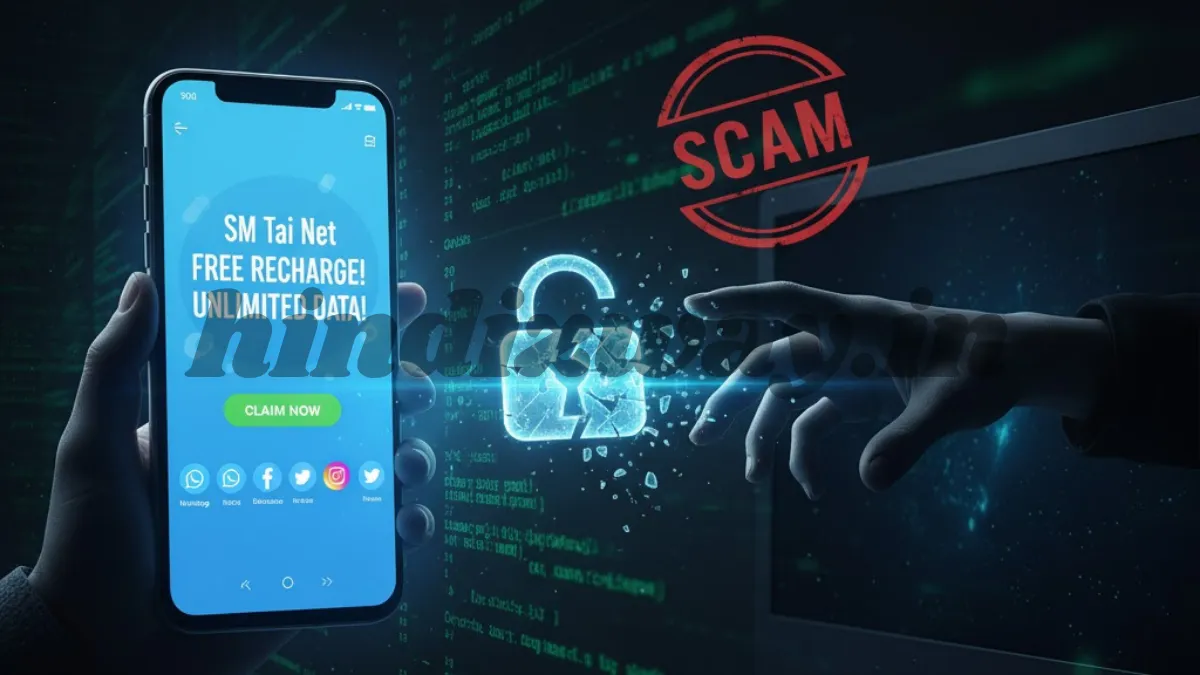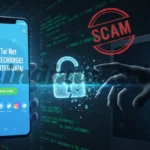SM Tai Net Free Recharge: Intrigued by the sm tai net free recharge offer? Before you click, read this essential guide. We expose the tactics behind free recharge scams, how to identify red flags, and the steps you can take to protect your personal information from phishing and fraud. Stay safe and learn about legitimate ways to save on your mobile expenses.
The Allure of “Free”: Deconstructing the SM Tai Net Free Recharge Phenomenon
In a world driven by digital connectivity, the promise of a “free recharge” can seem like an irresistible offer. The prospect of unlimited data, endless talk time, and extended validity without spending a single rupee is a powerful lure for any mobile user. It is this very temptation that cybercriminals exploit with schemes like the “sm tai net free recharge.” This seemingly benevolent offer, often circulated through social media and messaging apps, is not a gateway to free mobile services but a sophisticated trap designed to compromise your digital security and personal information.
This comprehensive article will serve as your guide through the murky waters of online recharge scams. We will dissect the anatomy of the sm tai net free recharge fraud, equip you with the knowledge to identify similar malicious campaigns, and provide you with actionable strategies to safeguard your digital life. We will also explore legitimate avenues for finding discounts and offers on mobile recharges, ensuring you can save money without sacrificing your security. The digital landscape is fraught with hidden dangers, but with the right knowledge, you can navigate it with confidence and security.
The Anatomy of a Scam: How the SM Tai Net Fraud Operates
Understanding the mechanics of the sm tai net free recharge scam is the first step toward effective prevention. These fraudulent campaigns are not random acts of mischief; they are carefully orchestrated operations that rely on psychological manipulation and technical trickery. By peeling back the layers of this deception, we can reveal the common tactics employed by cybercriminals.
Phase 1: The Bait – Crafting an Irresistible Offer
The foundation of the sm tai net scam is an offer that is simply too good to be true. Scammers understand that an outrageous promise will capture attention and bypass the initial skepticism of many users.
Leveraging Household Names and Acronyms
To lend an air of legitimacy to their fraudulent schemes, scammers often co-opt the names or acronyms of reputable organizations. In this case, “sm tai net” might be an attempt to mimic the sound of a legitimate tech company or a government initiative. The search query “smtai.net free recharge” often leads users down a rabbit hole of similarly deceptive websites. This tactic is designed to create a false sense of security, making users more likely to engage with the offer.
The Power of Unrealistic Promises
The core of the bait is the promise of something extraordinary for nothing. Common lures include:
- Three months of unlimited 4G/5G data.
- Free voice calls to any network.
- A massive data allowance, often hundreds of gigabytes.
- No hidden fees or conditions.
These offers are designed to be far more generous than anything a legitimate telecom operator would provide, creating a sense of urgency and exclusivity.
Phase 2: The Hook – Spreading the Deception
Once the bait is set, the next step is to disseminate it as widely as possible. Scammers use a variety of channels to ensure their fraudulent offer reaches a large and diverse audience.
The Viral Nature of Social Media and Messaging Apps
Platforms like WhatsApp, Facebook, Telegram, and Instagram are the primary vectors for spreading these scams. The sm tai net free recharge message is often framed as a “limited-time offer” or an “exclusive deal” and is shared rapidly through groups and individual chats. The ease of forwarding messages on these platforms allows the scam to achieve a viral reach in a very short period.
The Role of Phishing Websites
The shared message will almost always contain a link to a phishing website. These sites are designed to look like legitimate portals of telecom companies or government agencies. They may feature official-looking logos, branding, and a user-friendly interface to lull visitors into a false sense of security. The domain names are often chosen to be deceptively similar to real websites, with minor misspellings or different extensions (e.g., .net instead of .com or .gov.in).
Phase 3: The Catch – Harvesting Your Personal Information
The ultimate goal of the sm tai net free recharge scam is not to provide you with a free mobile plan but to steal your valuable personal data. The phishing website serves as the collection point for this information.
The Information Cybercriminals Are After
Upon visiting the fraudulent website, you will typically be presented with a form that asks for a range of personal details, including:
- Your full name
- Your mobile number
- Your email address
- Your home address
- Your date of birth
- Your telecom operator
In some more malicious versions of the scam, the website may prompt you to download a malicious app, which could contain spyware or malware capable of stealing your banking information, passwords, and other sensitive data directly from your device.
The Social Engineering Ploy
To complete the process, the website will often instruct you to share the scam with a certain number of contacts or groups on WhatsApp. This is a clever social engineering tactic that turns victims into unwitting accomplices, perpetuating the scam and expanding its reach. The promise of the free recharge is always just one step away, contingent on you spreading the fraudulent message to your friends and family. Of course, the recharge never materializes.
Red Flags and Warning Signs: How to Spot a Recharge Scam
While scammers are constantly evolving their tactics, there are several tell-tale signs that can help you identify a fraudulent recharge offer. Developing a healthy sense of skepticism and learning to recognize these red flags is your best defense against falling victim to these schemes.
If It Sounds Too Good to Be True, It Almost Certainly Is
This is the golden rule of online safety. Legitimate companies may offer discounts, cashback rewards, or bonus data, but they will never provide months of unlimited services for free with no strings attached. An offer that promises an exorbitant amount of data and free calls for an extended period is a massive red flag.
The Telltale Signs of a Phishing Website
Before you enter any information on a website, take a moment to scrutinize it for the following signs of a phishing attempt:
- Check the URL: Look closely at the website address in your browser. Scammers often use URLs that are very similar to legitimate sites but with subtle differences. Look for misspellings, extra characters, or unusual domain extensions. A secure website will also have a padlock icon in the address bar and a URL that begins with “https://” (the “s” stands for secure).
- Poor Grammar and Spelling: Legitimate companies invest heavily in professional copywriting and editing. Phishing websites, on the other hand, are often riddled with grammatical errors, spelling mistakes, and awkward phrasing.
- Generic Greetings: A phishing website will often use a generic greeting like “Dear Customer” instead of your name.
- Low-Quality Visuals: The logos, images, and overall design of a phishing site may appear blurry, pixelated, or unprofessional.
The Psychology of Urgency and Scarcity
Scammers often employ high-pressure tactics to rush you into making a decision before you have time to think critically. Be wary of messages that use phrases like:
- “Offer valid for today only!”
- “Only 100 recharges left!”
- “Act now to avoid disconnection!”
These messages are designed to create a sense of panic and urgency, prompting you to bypass your better judgment.
Unsolicited Contact and Suspicious Senders
Be cautious of unsolicited messages from unknown numbers or social media profiles, especially those promoting free offers. Legitimate companies will typically communicate with you through their official apps, websites, or verified social media channels.
Protecting Yourself: A Proactive Approach to Online Security
Safeguarding your personal information from scams like the sm tai net free recharge requires a proactive and vigilant approach to your digital habits. By implementing a few key security measures, you can significantly reduce your risk of becoming a victim.
The Power of Verification
Before you act on any offer, take the time to verify its authenticity.
- Go directly to the source: If you receive a message about an offer from your telecom provider, do not click on the link in the message. Instead, open your browser and navigate directly to the provider’s official website or open their official app to see if the offer is listed there.
- Conduct a quick search: A simple Google search for the name of the offer (e.g., “sm tai net free recharge scam”) will often reveal warnings, news articles, or forum discussions about the fraud.
Fortifying Your Digital Defenses
Strengthening the security of your devices and accounts is crucial.
- Use strong, unique passwords: Avoid using easily guessable passwords like “123456” or “password.” Create complex passwords that include a mix of uppercase and lowercase letters, numbers, and symbols. Use a different password for each of your online accounts.
- Enable Two-Factor Authentication (2FA): 2FA adds an extra layer of security to your accounts by requiring a second form of verification, such as a code sent to your phone, in addition to your password.
- Keep your software updated: Regularly update the operating system and apps on your smartphone and computer. These updates often contain important security patches that protect you from the latest threats.
- Install a reputable antivirus application: A good antivirus app can help detect and block malicious websites and apps.
The Importance of Digital Literacy
Educating yourself and those around you is one of the most effective ways to combat online scams.
- Be cautious about what you share: Think twice before sharing personal information online. Be especially wary of websites that ask for excessive details for a simple offer.
- Spread awareness, not the scam: If you receive a suspicious message, do not forward it to your contacts. Instead, delete it and consider informing the sender that it is likely a scam.
When the Worst Happens: What to Do If You’ve Fallen Victim
If you suspect that you may have inadvertently shared your personal information with a scammer, it is important to act quickly to mitigate the potential damage.
Immediate Steps to Take
- Change your passwords: If you entered any of your passwords on the phishing website, change them immediately on all accounts that use the same or similar passwords.
- Contact your bank: If you shared any financial information, such as your credit card number or bank account details, contact your bank or financial institution immediately to report the potential fraud.
- Monitor your accounts: Keep a close eye on your bank statements, credit card reports, and other online accounts for any suspicious activity.
- Report the scam: Report the fraudulent website and message to the relevant authorities. In India, you can report cybercrime to the National Cyber Crime Reporting Portal (www.cybercrime.gov.in) or by calling the helpline number 1930.
The Legitimate Path to Savings: Real Ways to Get Discounts on Mobile Recharges
While the promise of a completely free recharge is almost always a scam, there are plenty of legitimate ways to save money on your mobile expenses.
Official Telecom Operator Apps and Websites
Your first port of call for genuine offers should always be your telecom provider’s official app and website. Operators like Jio, Airtel, Vi (Vodafone Idea), and BSNL regularly offer:
- Exclusive app-only discounts.
- Bonus data on certain recharge packs.
- Cashback offers in partnership with digital wallets.
- Special plans with bundled subscriptions to streaming services.
Reputable Digital Wallet and Payment Platforms
Platforms like Google Pay, PhonePe, Paytm, and Freecharge are excellent resources for finding deals on mobile recharges. These apps often provide:
- Direct cashback on recharges.
- Scratch cards with surprise rewards.
- Coupons and vouchers for other services.
- Special offers for first-time users.
Loyalty Programs and E-commerce Platforms
Many e-commerce websites, such as Amazon, have their own payment platforms that offer rewards and cashback on utility bill payments and mobile recharges. Additionally, some credit and debit cards have loyalty programs that provide points or discounts on telecom expenses.
Frequently Asked Questions (FAQs)
Q1: Is the sm tai net free recharge offer real?
No, the sm tai net free recharge offer is not real. It is a fraudulent scheme designed to trick users into giving up their personal and financial information. There are no legitimate companies or government bodies providing such an offer.
Q2: What happens if I click on the link in a free recharge scam message?
Clicking the link will take you to a phishing website. If you enter your personal information on this site, it will be sent directly to cybercriminals. You may also be prompted to download a malicious app that could infect your device with malware.
Q3: Can a free recharge offer steal money from my bank account?
If you provide your banking details, credit card information, or UPI PIN on a phishing website, scammers can use this information to steal money from your account. Malicious apps downloaded through these scams can also be used to compromise your financial accounts.
Q4: How can I tell if a website is secure?
A secure website will have a URL that begins with “https://” and will display a padlock icon in the address bar. This indicates that the connection between your browser and the website is encrypted. However, scammers can sometimes obtain SSL certificates for their phishing sites, so this should be considered alongside other red flags.
Q5: Are all free recharge offers fake?
While offers for completely free, long-term recharges are almost always fake, legitimate companies do provide genuine promotional offers. These usually come in the form of cashback, bonus data on a paid recharge, or discounts through partner apps. Always verify these offers on the company’s official website or app.
Conclusion: In the Digital World, Vigilance is Your Greatest Asset
The sm tai net free recharge is a stark reminder that the digital landscape is not without its perils. Cybercriminals are constantly devising new and more sophisticated ways to exploit our trust and our desire for a good deal. The allure of “free” is a powerful tool in their arsenal, but it is one that can be effectively countered with knowledge and caution.
By understanding the anatomy of these scams, learning to recognize the red flags, and adopting a proactive approach to your online security, you can protect yourself and your valuable personal information. Remember to always question offers that seem too good to be true, verify information through official channels, and fortify your digital defenses. In the ongoing battle against online fraud, your vigilance is not just a recommendation; it is your most essential line of defense. Stay informed, stay skeptical, and stay safe.
Read More:
- HubComUAT.in: The Definitive Guide to User Acceptance Testing Excellence
- Earnkarado.com Instagram Password Check : A Comprehensive Guide to Security and Privacy
- Facts Reader Com Instagram Free Followers: The Ultimate Guide to Boosting Your Social Media Presence
- Vhumis WhatsApp Tracker: The Ultimate Solution for Monitoring WhatsApp Activity
- RG Technical Boy Free Recharge: Decoding the Free Recharge Phenomenon











 Free Recharge Apply !!
Free Recharge Apply !!
Jabbar khan